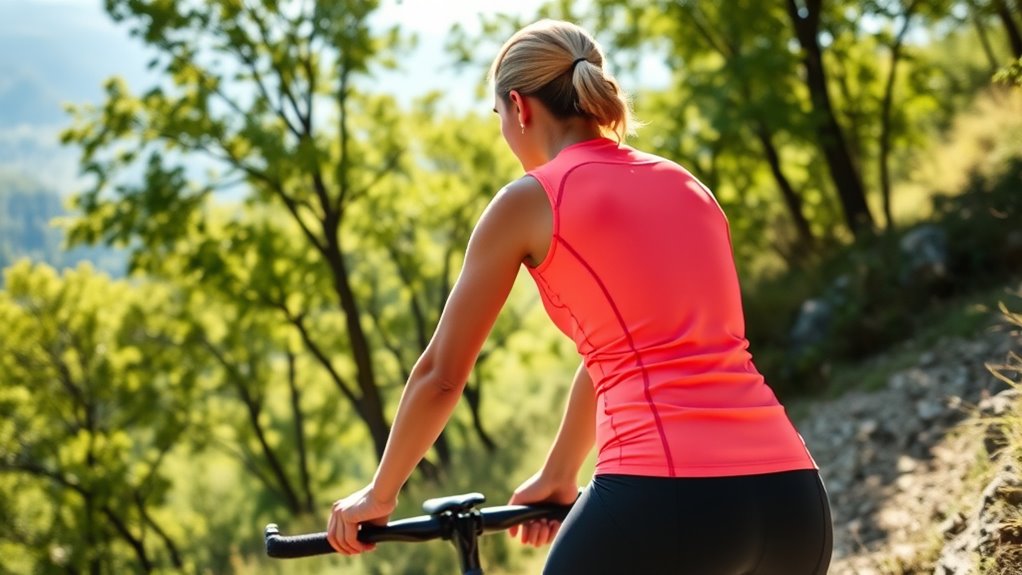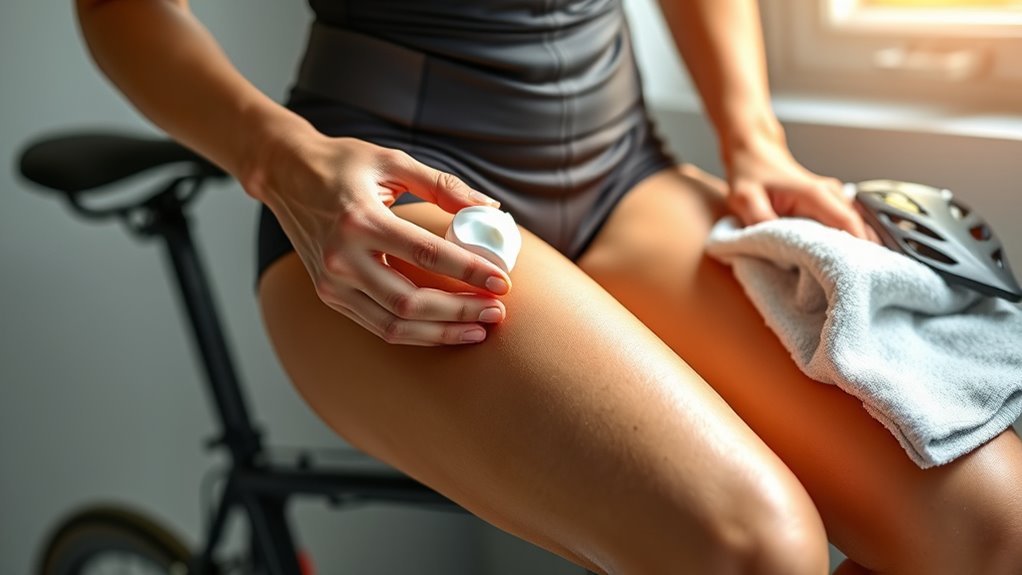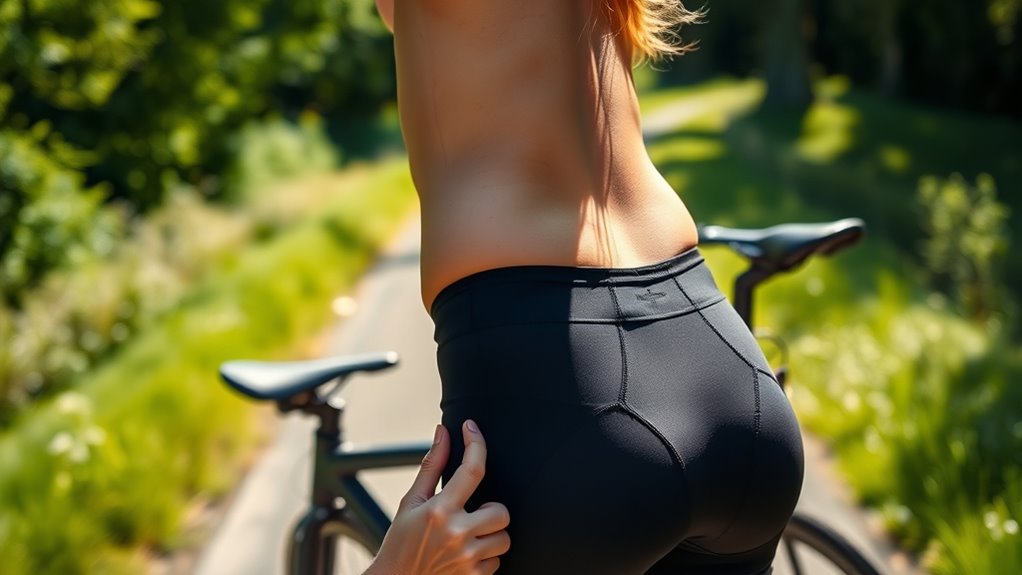To avoid saddle sores on long rides, choose a saddle that fits your anatomy, especially considering sit bone width, and make sure your bike is properly adjusted. Wear moisture-wicking, padded cycling shorts, and keep your skin clean and dry by showering afterwards. Use effective chamois creams or lubricants and change your position often to prevent friction. Gradually increase your mileage and learn how to incorporate breaks—discover more tips to stay comfortable and protected.
Key Takeaways
- Ensure proper bike fit and saddle selection that accommodates female anatomy for even weight distribution and support.
- Wear moisture-wicking, padded cycling apparel to reduce friction and keep skin dry during long rides.
- Take regular breaks and change riding positions to alleviate pressure and prevent irritation.
- Use lubricants or chamois creams to minimize friction and protect sensitive skin areas.
- Maintain good hygiene post-ride by showering promptly and inspecting skin for early signs of irritation.
Choose the Right Saddle for Your Anatomy

Choosing the right saddle for your anatomy is essential to prevent saddle sores. Your saddle fit should accommodate your unique body shape and riding style, ensuring proper support without excess pressure. Consider anatomical considerations like sit bone width and hip flexibility when selecting a saddle. A well-fitted saddle distributes your weight evenly, reducing friction and localized pressure points. Don’t settle for a one-size-fits-all approach—try different saddle shapes and sizes to find what feels best. Pay attention to the saddle’s width, padding, and curvature, making sure it aligns with your anatomy. Proper fit not only enhances comfort but also minimizes skin irritation and saddle sores, especially during long rides. Additionally, understanding proper saddle technology can help you choose a saddle with features that improve pressure distribution and reduce discomfort. Selecting a saddle with advanced materials can further enhance comfort and durability. Remember, a saddle that suits your body is your first step toward a more comfortable cycling experience. Incorporating ergonomic design principles into your saddle choice can also contribute significantly to long-term comfort and injury prevention. Being aware of AI-driven customization options can also lead to finding a saddle tailored specifically to your unique anatomy.
Wear Proper Cycling Apparel

Wearing the right cycling apparel can make a big difference in preventing saddle sores. Choose moisture-wicking fabrics to keep you dry and comfortable during long rides. Padded shorts provide extra cushioning and reduce friction, protecting your skin from irritation. Additionally, selecting apparel with breathable material helps regulate body temperature and reduces chafing. Using properly fitted clothing ensures minimal movement and prevents unnecessary rubbing that can lead to soreness. Incorporating advanced textile technology can further enhance moisture management and comfort during extended cycling sessions.
Choose Moisture-Wicking Fabrics
Opting for moisture-wicking fabrics is essential to keep your skin dry and prevent saddle sores during long rides. These fabrics excel in fabric breathability, allowing air to flow and reducing sweat buildup. Good moisture management pulls sweat away from your skin, keeping you comfortable and reducing irritation. Look for materials like polyester, nylon, or blends designed for active wear, as they dry quickly and promote airflow. Avoid cotton, which absorbs moisture and stays damp, increasing your risk of chafing. Proper moisture-wicking apparel helps maintain a dry, friction-free surface between your skin and saddle, lowering saddle sore chances. Additionally, selecting breathable fabrics can enhance overall comfort and help regulate your body temperature during long rides. Incorporating antimicrobial properties in your clothing can also reduce odor and bacterial buildup, contributing to better skin health on extended rides. Choosing fabrics with moisture-wicking technology can further improve sweat management and comfort throughout your ride.
Opt for Padded Shorts
Investing in padded shorts offers targeted cushioning that reduces friction and pressure on sensitive areas during long rides. Padded shorts are essential for enhancing saddle comfort and preventing saddle sores. They wick moisture away from your skin, keeping you dry and comfortable. Properly fitted padded shorts prevent chafing and allow for smooth movement, reducing irritation. When choosing cycling apparel, consider best anime movies for inspiration on quality and comfort. Wearing padded shorts can make a significant difference on long rides, helping you stay comfortable and focused. They provide the necessary support and reduce the risk of saddle sores by minimizing friction and pressure. To further improve comfort, look for padded shorts with moisture-wicking fabric that keeps sweat away from your skin. Additionally, selecting breathable materials can enhance airflow and prevent overheating during extended rides, ensuring a more enjoyable experience. Prioritize good padding and fit for a smoother, more enjoyable cycling experience.
Maintain Good Hygiene and Skin Care

Maintaining good hygiene and skin care is essential in preventing saddle sores. You should establish simple hygiene routines, such as showering immediately after long rides to remove sweat and dirt that can irritate your skin. Keep your skin clean and dry, especially in the saddle area, to reduce bacteria buildup. Skin hydration is also vital; use gentle, fragrance-free moisturizers to keep your skin supple and resilient. Regularly inspect your skin for signs of irritation or chafing, and address any issues early. Avoid wearing damp or dirty clothing, as this increases the risk of soreness. Staying consistent with these hygiene habits helps maintain healthy skin, minimizes friction, and creates a protective barrier against saddle sores during your long rides. Additionally, paying attention to skin health can significantly improve your comfort and prevent long-term irritation. Incorporating proper saddle fit can also reduce unnecessary pressure and friction on sensitive areas.
Use Effective Chamois Creams and Lubricants

Using effective chamois creams and lubricants can considerably reduce friction and moisture buildup during your rides. These products create a protective barrier that minimizes skin irritation and saddle sores. Apply a generous amount of chamois cream before each ride, especially if you tend to sweat heavily. After rides, use antibacterial wipes to clean the area thoroughly, preventing bacterial infections. For extra comfort, soothe irritated skin with soothing balms that promote healing.
Use chamois creams and lubricants to prevent irritation and saddle sores during rides.
- Choose creams with antibacterial properties to keep bacteria at bay
- Reapply lubricant during long rides to maintain comfort
- Incorporate soothing balms post-ride for skin recovery
Optimize Your Riding Position and Technique

To prevent saddle sores, focusing on your riding position and technique is essential, as improper alignment can cause unnecessary friction and pressure on sensitive areas. Make certain your bike fit is correct; an improper bike fit can lead to awkward riding stance and increased chafing. Adjust your saddle height so that your knee slightly bends at the bottom of each pedal stroke, promoting a more comfortable riding stance. Keep your hips steady and avoid excessive rocking, which can create unnecessary friction. Engage your core to maintain stability, and shift your weight forward or back as needed to distribute pressure evenly. Proper technique and a well-fitted bike help minimize skin irritation and reduce saddle sore risk on long rides. Additionally, understanding security zone info can help ensure your riding environment is safe and secure. Being aware of self watering plant pots can also be useful for maintaining a comfortable and stress-free riding environment when caring for your plants at home. Ensuring your bike components are well-maintained can also contribute significantly to your riding comfort and saddle sore prevention.
Incorporate Regular Breaks and Adjustments

Taking regular breaks helps relieve pressure and prevents soreness from building up. Make a habit of changing your riding position often to reduce friction and irritation. By scheduling rest periods and shifting your posture, you can keep discomfort at bay and protect your skin. Incorporating proper hydration into your routine can also aid in skin health and overall comfort during long rides. Additionally, ensuring your bike is properly fitted and maintained can help minimize pressure points that contribute to saddle sores.
Schedule Rest Periods
Scheduling regular rest periods is essential to prevent saddle sores and give your skin a chance to recover. Taking short breaks allows you to reassess your hydration strategies, ensuring your skin stays moist and reduces friction. Use these pauses to stretch and maintain mental focus, preventing fatigue that can lead to poor riding posture. During rest, adjust your saddle position if needed to prevent pressure points. Incorporate these tips:
- Plan breaks every 30-60 minutes to stay hydrated and refreshed
- Use rest time to check for chafing or irritation
- Keep your mind alert and attentive to your comfort levels
- Regularly assess and revisit your riding gear and setup to maintain optimal comfort and prevent issues. Incorporating proper saddle fit can also significantly reduce the risk of saddle sores and improve overall riding comfort. Additionally, understanding pressure distribution can help you identify and alleviate pressure points before they develop into sores.
Change Positions Frequently
Frequent position changes during your ride help distribute pressure evenly and reduce the risk of saddle sores. Adjusting your bike fit guarantees you’re comfortable, making it easier to shift positions naturally. Incorporate regular breaks to stand up and stretch, relieving pressure on sensitive areas. Using a saddle with adequate padding can also make a difference; softer or more supportive saddle padding minimizes friction and soreness. Don’t stay in the same position for too long—small adjustments, like leaning forward or shifting to one side, help prevent persistent pressure points. Keep your bike fit optimized so that these changes feel natural and comfortable. By blending proper bike fit, saddle padding, and regular adjustments, you’ll reduce discomfort and saddle sore risks during long rides.
Build Up Mileage Gradually and Listen to Your Body

To prevent saddle sores, it’s essential to build up your mileage gradually rather than jumping into long rides too quickly. This approach, called progressive training, helps your body adapt safely and reduces discomfort. Pay close attention to your body awareness—notice signs of fatigue or soreness early. Increase your riding distance by no more than 10-15% each week to avoid overloading your muscles and skin.
Gradually increase your riding distance by no more than 10-15% weekly to prevent saddle sores and promote safe adaptation.
- Start with shorter rides and extend gradually
- Rest adequately between longer sessions
- Adjust your bike fit if you notice persistent discomfort
Listening to your body allows you to identify trouble spots before they become serious. Patience and gradual progress are key to avoiding saddle sores and enjoying long rides comfortably.
Conclusion
By blending the basics with a bit of bravery, you can banish bothersome saddle sores. Be mindful of your body’s signals, switch up your saddle setup, and stay squeaky clean from saddle to skin. With wise wear, proper positioning, and regular breaks, you’ll ride on with confidence and comfort. Remember, consistency is key—comfort and care cultivate a carefree cycling experience, so stay vigilant, vigilant, and victorious on every ride!









